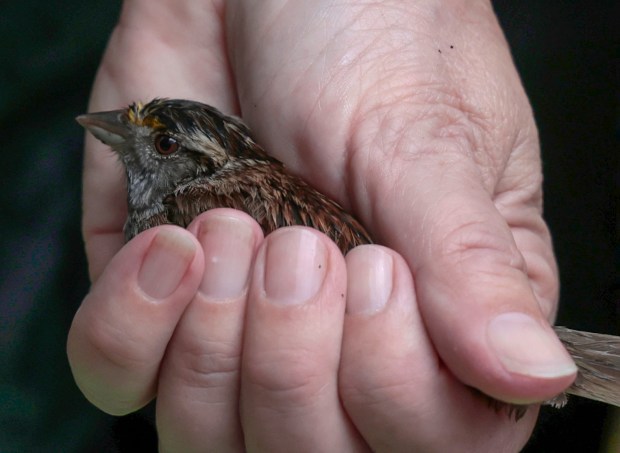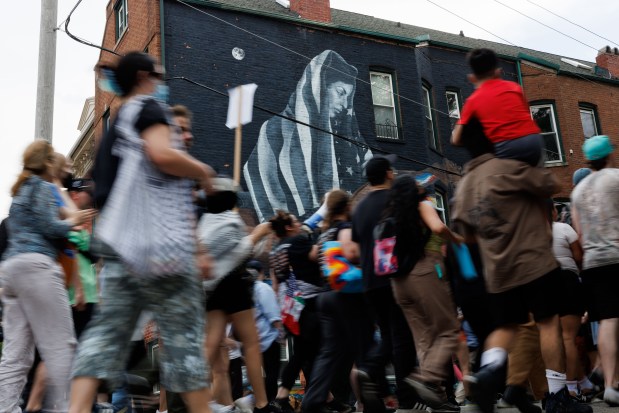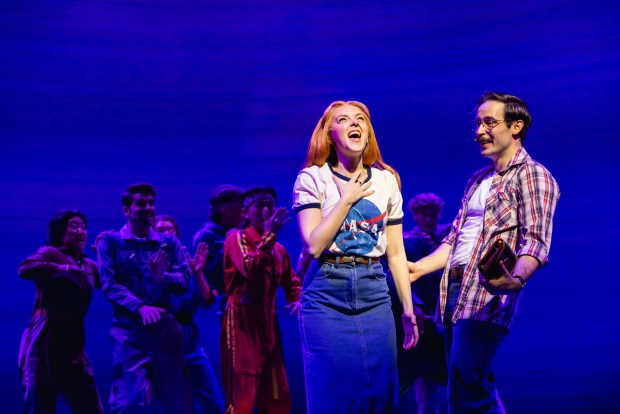Annette Prince peered between glossy downtown buildings: ”There’s a bird in that grate.”
Sure enough, sitting very still in the rain was a tiny white-throated sparrow, so drenched you could barely make out its canary-yellow face markings. The bird was too dazed to move — an easy target for the hungry seagulls that were patrolling the area.
Prince looked up at the nearest skyscraper, with its rows of dark windows.
“He probably hit the glass up there and fell down,” she said.
A long-awaited policy update from the city of Chicago is supposed to help prevent such injuries and deaths, which occur by the thousands each year when migrating birds crash into local buildings.
But Chicago bird safety advocates say they are disappointed that the city’s policy update, now in draft form, does not make bird safety measures mandatory.
Instead, anti-collision measures, which can include installing glass with tiny markings, are included in a menu of sustainable design options from which developers working on affected projects can pick and choose.
“We feel it’s not adequate,” said Prince, chair of Bird Friendly Chicago, a coalition of local birding and conservation groups that’s been working for bird-safe building measures since 2016.
“(These measures) are not just bonuses — they’re essential to protecting valuable bird lives and a healthy environment, that these birds are foundational to. They’re good for people. They’re good for birds,” she said.
Chicago Department of Planning and Development Deputy Commissioner Peter Strazzabosco pointed out that the proposed policy update, available for public comment until May 15, gives additional weight to bird-safe building options.
Under the update, one category of bird safety measures would be awarded 30 points, compared with just 10 points under the current policy.
Those points count toward the 100 points that certain new buildings and renovations must earn — by choosing from a list of sustainability options — if the project developers want the city’s permission to build.
“(The new policy) has incentivized the bird-friendly design section by tripling the point total (in one category), and by including, for the first time, an implementation section that helps developers figure out how to use bird-friendly measures in their projects,” Strazzabosco said.
The draft sustainable development policy update would typically apply to about 50 to 75 new or renovated buildings a year, many of them larger projects that are getting some form of assistance from the city, he said.
The proposed update, the first since 2017, comes less than a year after at least 960 birds died in a single day after crashing into McCormick Place Lakeside Center, a glassy, low-lying convention building on the lakefront.
Birds were crashing into windows even as monitors collected the casualties, according to David Willard, a retired bird division collections manager at the Field Museum.
“It was just discouraging as can be,” Willard told the Tribune. “You’re looking at a rose-breasted grosbeak that, if it hadn’t hit a Chicago window, would have made it to the Andes of Peru.”
McCormick Place Lakeside sought expert advice immediately, and has set a goal of installing about $1.2 million worth of bird-safe film on all its windows in time for the fall migration season, according to Larita Clark, chief executive officer at the Metropolitan Pier and Exposition Authority, which owns the building.
But Chicago, which is located in the Mississippi Flyway — a major bird migration route — remains a perilous place for millions of birds that fly through each year, some from as far away as South America and northern Canada.
Prince, the director of Chicago Bird Collision Monitors, said the all-volunteer organization recovers 7,000 to 10,000 dead and injured birds a year — and that’s just a small fraction of the city’s casualties.
During a walk through the Loop, she pulled out her phone to show an array of birds, including an injured meadowlark and a deceased northern flicker with a spotted belly and bright yellow feathers on the undersides of its wings.
The losses come at a time of growing concern about North American birds, which are in the midst of a “staggering” population decline, according to a widely quoted 2019 study in the journal Science.
The study found a net loss of 2.9 billion birds since 1970, a 29% population decline.
A wide range of threats were cited in the study, including habitat loss, agricultural practices, coastal disturbances, climate change and deaths due to human activity, a category that includes collisions with buildings.
Through the years, Chicago has made some major efforts on behalf of the tiny visitors, including a seasonal late-night lights-out program.
Prince’s group patrols a high-risk section of downtown Chicago during spring and fall migration, rescuing birds as well as providing casualty counts.

The white-throated sparrow that Prince spotted on a grate was easy to catch: She came up behind him with a net, then gently placed him in a brown paper bag for transfer to the Willowbrook Wildlife Center.
He didn’t seem harmed, just dazed, Prince said, and he was very likely to recover and be released back into the wild.
Despite such success stories, bird advocates say that the transparent and reflective surfaces of Chicago buildings, as well as certain gratings and landscape and lighting practices, continue to create peril.
Advocates began pushing the city for bird-safe building design measures in 2016, with early efforts focusing on an ordinance.
In 2020, advocates turned their focus to a planned update of the city’s sustainable development policy.
Prince said she and her allies were clear, from the beginning of their discussions with the planning department, that they were calling for bird safety requirements, not options.
“It’s an understanding they had from us, and they continued to indicate that was the direction they were taking,” said Prince.
She said the word “required” was used in the department’s presentations and slides until the end of 2023, and then there was “a reversal at the 11th hour.”
“We feel that we wasted four years, and in those four years, hundreds of buildings have gone up that in their lifetime are going to kill thousands of birds,” she said.
Strazzabosco said that he wasn’t going to dispute what bird advocates “may have heard or what they thought they heard.”
“I’m kind of uncomfortable talking about this he said, she said stuff because neither of us was in the room, but I can tell you that mandatory menu items were suggested, but anything presented was in the discussion phase; it wasn’t final,” he said.
Strazzabosco said that policy documents such as the sustainable development policy update don’t have the authority to create mandates; that typically requires an ordinance with a City Council vote behind it.
At the nonprofit American Bird Conservancy, which tests and rates bird-safe building options, glass collisions program director Bryan Lenz said that point-based policies such as the Chicago sustainable development policy update are more effective than purely voluntary measures but less effective than requirements.
Faced with a menu of sustainable building methods and materials, developers tend to pick ones that are more familiar to them, such as water-conserving low-flow toilets, he said.
“I don’t think (Chicago’s proposed policy) would have the impact anybody was hoping for in terms of reducing collisions,” he said.
Since 2017, about 30 projects have chosen bird safety from Chicago’s menu of sustainable building strategies, Strazzabosco said. That’s approximately 10% of the projects that had to choose from the menu.
Other menu options include energy efficiency, greenhouse gas emissions reduction, landscape and green infrastructure, public health and community benefits, stormwater management, sustainable transportation, waste diversion and water use reduction.
The policy update was released as a draft April 15. A final policy will be posted online July 1, and the policy will be fully implemented in January, according to the planning department.
The owners of McCormick Place Lakeside are finalizing a contract to apply bird-friendly patterns to all the building’s windows, according to Clark.
The glass will be marked with tiny dots — applied via a removable film — that will warn birds they are approaching a hard surface. Workers are also closing blinds at the building, unless customers request otherwise.
Prince said that regardless of what happens with the proposed policy update, bird advocates plan to pursue an ordinance with bird-safe building requirements.
New York, San Francisco, Washington, D.C., Skokie and Evanston already have local laws with such requirements.
“We think that’s a direction that’s going to put the strongest protections in place,” Prince said.
nschoenberg@chicagotribune.com





